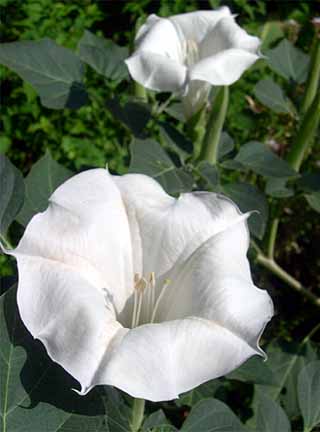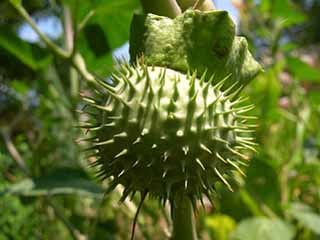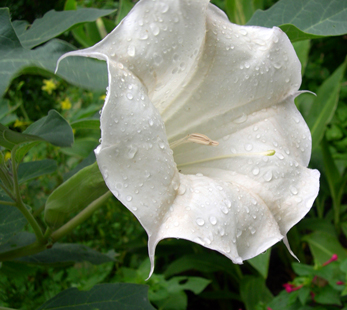Plant Profiles Index > Datura inoxia
A rank and dangerous weed. Extremely poisonous. Yet, you can buy potted plants of it at local Austin nurseries and seeds from various mail order sources. Why plant it? Because the huge, trumpet shaped flowers are irresistable.
The soft hairy leaves have a distinct unpleasant scent, which reminds me of stale peanut butter sandwiches from elementary school brown bagged lunches. (Still another name for it is stinkweed.) In the worst of the summer's heat, the leaves droop pathetically. The whole plant can look quite, well, weedy. If I'm feeling in a tidy mood, I'll pick off the brown leaves and prune back the cracked stems. But come rains in late August and early September and Datura inoxia springs back to life, covered with new flowers.
To keep Datura inoxia flowering, don't let it set seeds. You can snap off the thornapples, but you might prefer to snip them off with shears. Each little thornapple is filled with seeds and once you have Datura inoxia, unless you are very vigilant, you'll discover it popping up all over the yard in the years to come. I've read that Datura is a root-hardy perennial. In my garden, an individual plant may last through a winter or two. Typically they are short-lived and quickly replaced by self-seeding.
All parts of Datura inoxia are poisonous. Various cultures have used them to achieve altered states of consciousness. If you have small children or pets who like to nibble in the garden, do not plant Datura.
 Photo: Datura inoxia flower. One common name is angel trumpets. 2003-08-22 Austin, TX
Photo: Datura inoxia flower. One common name is angel trumpets. 2003-08-22 Austin, TX
 Photo: Datura inoxia seedpod. Another common name is thornapple. 2003-08-12 Austin, TX
Photo: Datura inoxia seedpod. Another common name is thornapple. 2003-08-12 Austin, TX
